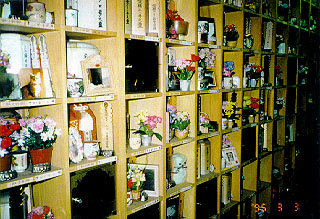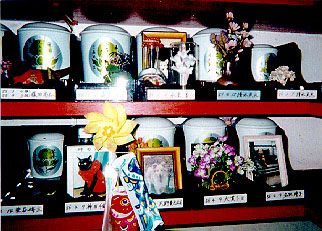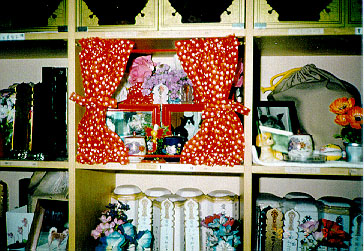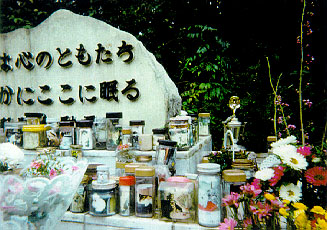|

The Case of "doubutsu no haka no shashin":
The Use of Snapshots in Japanese Pet Cemeteries.

Introduction
Amateur photography in the Japanese
context provides us first with a curious dilemma.
Western observers including social scientists and
international tourists have consistently commented
on the overwhelming popularity of photography for
the Japanese. For many people, the sight of Japanese
people taking snapshots has virtually become an icon
of Japanese society and culture. I've had no trouble
recording personal accounts of this popular stereotype.
In one report from the English language newspaper
The Asahi Evening News I read: "The Japanese
and cameras are inseparable" and "Japanese
people have camera hands" (Takahashi, 1994).
Psychologically-grounded explanations and comments
have been suggested first. For instance I have read
that the Japanese people are "mentally stingy"
and have a "miniature garden mentality."
However there are virtually no accounts that take
this observation substantially further, that is, by
placing this activity into a broad-based cultural
context. This domain of visual studies remains undone
in Japanese scholarship.
The primary objective of my
study has been to understand better the significance
of Japanese personal photography in contexts of home
media, home mode communication, and Japanese culture.
I have been examining the ways in which Japanese people
have constructed and communicated meanings of their
own lives through the making, using and collection
of family pictures. Whenever possible I have been
including studio photographs, home movies and home
videotapes. This project focuses on the cultural significance
of vernacular imagery by exploring relationships between
technology and culture, socialization and personal
media, private communication and family structure
as well as memory and family history. Thus the topic
of pet cemetery snapshots discussed in this short
paper comes from a much larger on-going study.
The following paper ties
together interests in both visual sociology and visual
anthropology. Common themes include attention to family
and home, kinship, social organization, and what I will
call "the canine- and/or feline-extended family."
Other important reference points include Goffman's "keys
of reality", models of social semiotics, identity
formation and maintenance, studies of everyday life,
and common sense as related to local knowledge. Current
literary interests in "native voices" and
indigenous expression have visual counterparts that
have only recently been examined in depth. In past years,
however I have tried to bring some of these themes to
a sense of "us" -- that is, to dominant, mainstream,
middle class Anglo-American culture. In short, I am
suggesting a fresh look at taken-for-granted materials
and activities, at the visual/pictorial renditions of
what anthropologist Clifford Geertz would call "the
stories that people [the Japanese] tell about themselves
to themselves" (1973: 448).
The central interest of this new
work on the construction, use and interpretation of
home media in Japan. I am interested in knowing how
Japanese people have organized themselves and their
thinking to participate in the broader framework of
"Camera Culture" -- a term brought forward
by Halla Beloff (1985) including anthropologist
Margaret Blackman's "the culture of imaging"
(1986), as long as that concept includes audience behaviors
and, especially, attention to schemata of interpretation.
My work has been with just one piece of camera culture,
namely home media and the home mode of pictorial communication.
back
to top

Methods.
Living in Tokyo while teaching
Visual Anthropology and American Studies at Temple University
Japan (TUJ) for two years offered me many opportunities
for personal daily observations of picture-taking and
picture use. For example. I was able to buy photograph
albums at flea markets -- though I often did not know
what I had bought, requiring that I get subsequent interpretation;
from previous connections in Rochester, New York, I
was able to arrange several interviews with personnel
at Eastman Kodak Pacific Ltd. I also developed an undergraduate
course entitled "Pictorial Lives" to train
Japanese research assistants. And perhaps most valuable
and important, during the summer of 1996, with the helpful
introductions from some TUJ students, I was able to
return to Tokyo to continue making personal visits and
conducting interviews with Japanese family members in
their homes.
However, as might be expected,
I encountered several serious problems. I was not able
to develop my Japanese speaking abilities to do interviews
by myself. I, as a gaijin/outsider, was asking
very unusual questions for Japanese people about private
materials. And, I ran into all the problems of context
bound information of a "high-context culture."
I was also handicapped in that I could not locate any
previous studies of Japanese home media to make intra-cultural
comparisons.
back
to top

The Case
of Pet Grave/Funerary Photography.
The example under discussion
is known in Japanese as doubutsu no haka no
shashin translated as animal grave pictures.
The use of photographs in conjunction with Japanese
human deaths, funerals and grave sites has been discussed
by several authors, namely Robert Smith (1974) and
David Plath (1964), just to mention two. Most frequent
comment is made of 8" by 10" black and white
portrait photographs kept in the butsudan,
or household alter dedicated to recently deceased
family members.
But virtually nothing has
been said about connections between personal photographs
and household animal pets -- either while they are alive
or dead. Common to many parts of the world, but certainly
not all, I learned that many Japanese commonly treat
their pets as family members, as furry "children",
as brothers and/or sisters, so to speak. We learned
that pets are a common subject of photographs carried
in wallets or schedule books and sometimes framed and
placed at bedside. But what happens after a beloved
dog or cat dies?
The tradition of a pet burial
site in Japan is more formally recognized than in sectors
of American culture. Pet cemeteries are indeed known
in the United States, but generally speaking they are
thought of as an oddity, as some kind of eccentricity.
Not so in Japan where pet burial habits are treated
more seriously and not as unusual. We learned that different
practices prevail in different regions of Japan. Also
there is considerable variation in religious beliefs.
In one interview, I heard the following:
In Buddhism there
are different sects and some sects believe that animals
are reincarnations of their great ancestors. For this
reason, the owners of the pet can not let others take
care of their pet after it dies. They think that an
evil spell will be cast upon the family if they don't
bury the animals properly. This Buddhist sect allows
people to put the ashes of the human being and the
pets in the same family altar. Other Buddhist sects
will be furious if they saw a picture of a dog in
the butsudan (family altar). Because they believe
that animals have their own heaven, paradise, or kingdom
after they die and the same goes for human beings.
(J. O.)
We discovered at least seven
pet cemeteries within the Tokyo metropolitan area. Jindaiji,
located just west of Tokyo in Chofu-shi is a Buddhist
temple that was built in 733. This temple has set aside
a section of its property and buildings for use by an
independent business firm that leases pet grave sites.
This pet cemetery has been open since March, 1962.
Upon approaching the pet cemetery
section of Jindaiji, we see signs wishing "good
rest" for animals along with lanterns decorated
with astrological signs and mention of the Goddess of
Mercy. Along the wall surrounding the charnel house,
we find commemoration sticks (used with grave stones)
called tooma. These sticks include an inscritption of
the pet’s name and are used to signal the visit
of pet masters to particular grave sites. And here is
where we find first evidence of snapshot use. Some pet
owners secure snapshot images of their deceased pet
to the tooma.
back
to top

Interior
Grave Sites.
Directly inside the charnel house,
we find a mass grave site containing the cremated remains
of many animals. For reasons of cost, pet owners may
deposit these remains here instead of having individual
graves. Just to the side of this communal grave we find
additional evidence of roles played by snapshots. Owners
are invited to deposit a favorite photograph of their
deceased pet in this photograph album. In this way the
album represents the contents of the mass grave.
Typically, charnel houses are
lined with walls of lockers containing individual grave
sites, many of which are a meter square cubby. Most
have open fronts but some have plexiglas covers, and
a few even have curtains. By our estimates, 90% of the
deceased animals were dogs and cats, averaging 70 percent
dogs and 20 percent cats. But these graves also included
rabbits, hamsters, guinea pigs as well as birds, monkeys,
mice, and in one case, a raccoon.

As we move closer to individual
graves, we see that each cubby contains roughly the
same items, including flowers in small vases, an urn
for the pet’s ashes, a decorated ceramic container
for water, the pet's favorite can of food and small
toy, and possibly the pet's collar. In some cases, I
also noticed the pet's pedigree certificate. We also
found a memorial tablet called an ihai in the majority
of these graves. This mirrors Buddhist traditions surround
human burials. I learned later that a photograph can
substitute for the ihai in pet graves. name plate are
called a mini-Tooba. These markers included the pet's
name and the family's surname, e.g. Popo Nakamura or
Willi Nagano. But in some cases, pets are accorded posthumous
names as in adult Buddhist practices.

What is striking and relevant
for this study is the frequent inclusion of a photograph.
A business manager at Jindaiji Temple in Chofu-shi estimated
that 80 percent of their shrines contained pictures.
Of all the cemeteries studied for this project, between
60 percent and 80 percent of these individual graves
contained a photograph of its occupant. One report stated
95 percent. However not as many owners put their pets'
photographs in the album kept for joint graves/shrines
as mentioned earlier.

The majority of the photographs
found in these charnel house graves were quite similar
to one another: three-by-five or five-by-seven inch
snapshots, framed and often displayed on a miniature
easel. They were all color pictures instead of black
and white as in most human shrines. All the pets shown
in these photographs shared similar poses, looking directly
into the camera and with similar "expressions"
-- one interviewee felt "they are all kind of "smiling"
in the pictures. It (this) shows that they had good
relationships when they were alive."
We also noticed that pets are almost always alone, and
more to the point, the pets' masters are not in these
photographs. An executive in one cemetery's business
office offered the following reason: "Masters do
not want to be included in the picture in shrines because
it would bring them fears of being invited to where
the pets are now." However we did notice that masters
can appear with their pets when the photographs are
displayed at home (possibly in the master's bedroom)
or in one of the family's photograph albums.
back
to top

Exterior
Grave Sites.
However not all graves are inside a charnel house; we
also found exterior cemetery sites. Suburban or country
locations are more likely to be outside with grave markers
much like human cemeteries. The pet's part of the cemetery
is also likely to have a statue of the Goddess of Mercy
for animals (Junnishi-Kwannon) placed in front. Incense
sticks may be offered and burned at the entrance to
the cemetery -- some additional indication that there
is a belief in life after death for these animals.
In one case we discovered a outside setting with grave
stones; nearby there was a stage-like table with clear
bottles each containing a pet's photograph. These pictures-in-bottles
served as the grave markers for owners who did not purchase
or lease an individual or group plot (see accompanying
photographs). But it was sad to notice that many of
the color pictures were fading because of exposure to
the sunlight and some were becoming damp with exposure
to rain and humid weather.

Many people interviewed for this
study felt they should come to the grave site and pray
once a month, similar to patterns for recently deceased
human relatives. Business Office personnel told us that
between 250 and 300 people visit Jindaiji on an average
weekday and around 500 on weekends, especially Sundays
and holidays. Eighty percent of the visitors are usually
women (60-70%) and older (50+) women. One woman felt
"her pet might be lonely if she kept away from
the cemetery for a long time " -- this would ensure
the existence of a pleasant after-life with "quiet
sleep" for her pet. Worries about a pet's loneliness
were frequently heard.
In another example, a woman was
pleased to note that these cats can have a nice (after)life
with many other cats. But in one cemetery, exclusively
reserved for only dogs and cats, one woman remarked
that it was "strange that dogs and cats are buried
next to one another because they might not get along
and even fight.." She added: "If I were a
dog I certainly wouldn't like this idea... What a misfortune.
"
back to top

Discussion.
Naturally we sought some understanding for what people
felt they were doing when they leased grave sites for
their deceased pets in this manner, and specifically
when they included photographs. Not surprisingly, we
frequently heard: "Because other people do it"
and "To console them (pets) like a human being,
you know." (Yoko K.) Most people interviewed for
this study said they came to the grave to "meet"
their pet in the cemetery.
And as part of "meeting
their pets," I was personally interested to learn
if visitors used pet cemeteries for purposes of pet-human
communication. Are these photographs used to interact
with their deceased animals? Could these images serve
as a medium of communication into the pet's afterlife?
Some people were seen and heard to be mumbling when
standing in frontof the grave and staring at the pet's
photo. One interviewee stated: "it is easier for
people to talk if there is a picture in front of them."
Some visitors leave short one-line messages such as
"Thank you for all the work you did" and others
leave letters for their departed pet -- for instance,
we discovered a grave that included a letter to a dead
cat from the family. In short, it is highly likely that
snapshots are used as a channel of communication, not
unlike how portraits are used in household butsudans
for interpersonal human communication. As many observers
have noticed, it is very important for Japanese people
to stay in touch with their recently departed relatives.
Thus we find another role of visual/pictorial communication
in everyday life.
When asked specifically
about the use and appearance of photographs, responses
were quite uniform. People stressed the theme of memory
retention. One person said, "Their memories of
playing with their pets are very important for them.
So they want to save the memories as photographs."
(K.O.) Many interviewees said they wanted to recall
the looks of their animal and help keep their memories
alive: "To keep the image of a dead pet in their
minds." Later this woman added that people believe
"memories for [of] the appearance of the pet can
not continue to be in people's minds for a long time
unless people have photographs to recall the appearances
of their pets and all other memories of their pets."(N.G.)
Thus we see the ‘aide de memoire’ function
highlighted in these responses.
However it was possible
to detect something more powerful beyond the fundamental
function of jogging and reinforcing one’s memory
-- something more significant about the existence of
photographs. In the last quote we heard the phrase "unless
people have photographs..." In another instance,
one student summarized her survey results as follows:
"I feel that people go to "see" the pets
they love. But because the spirits of them are invisible,
they display those pictures so that they can always
see them through the photographs." (T.O.) And in
other examples, people expressed a desire to extend
the "life" of their pets through the use of
photographs. In one report, I read "people want
to feel like their pets are still alive by seeing pictures...
making people remember how happy they were with (their)
pets and what they got from them." (N.N.) One student
summarized that these pictures "are not for the
animals, but for human beings who take it and see it...
by placing photos, people can console themselves, for
those pictures may help them to believe that their pets
exist somewhere." (Y.K). There is a sense that
photographs are capable of more than we in the West
generally think.
back to top

Relationships
to Japanese Culture.
Before going on, let emphasize
that I do not highlight this example of "doubutsu
no haka no shashin" as an exercise in exoticising
Japan or Japanese culture. Other sources -- especially
news reports and feature films as well as the mass media
in general -- do that quite well. Rather, I use it as
an entrée point to other salient features of
Japanese culture. With some additional work, I would
like to see this as a kind of semi-medium-thick description,
one that replaces a cockfight with pet cemetery photography,
and one that serves as a launching pad into other features
and domains of the culture. A perspective grounded in
relating culture to communication should facilitate
such an effort as we seek to find connections between
such topics as kinship and social organization, ritual
behaviors, interpersonal and small group communication,
as well as relationships between secular and sectarian
behaviors and activities.
The doubutsu no haka no
shashin I have been discussing play important
roles in lives of their Japanese custodians. These images
have important connections to cultural characteristics
well documented in the literature on Japanese society
and culture. For instance, using photographs in pet
grave sites can be related (1) to the cultural significance
of staying connected to the central unit of Japanese
social organization, specifically ie or the household,
-- but in all published accounts I have read, this notion
has not included non-human members. In turn, we can
see relationships (2) to ratifying a sense of personal
and group belonging, (3) to taking short and long term
responsibility for family members in significant ways,
(4) to keeping life orderly and maintaining a good (usually
meaning pleasant) set of personal relationships, (5)
to maintaining and reinforcing good memories, and (6)
to adhering to beliefs in an after-life-existence.
It is perhaps this last point
which might enhance a cross-cultural appreciation of
photographic representation and communication.. By exploring
the cultural significance of doubutsu no haka
no shashin we can see connections to animistic
beliefs that are so alive and well amidst Japanese daily
life. In turn, we are encouraged to examine an alternative
belief system surrounding the making and use of photographs
and to reconceptualizing photographs as a medium of
information and communication -- perhaps more powerful
than we are accustomed.
Finally, I am tempted to introduce
the notion of a "carrying capacity" of photographic
representation. In addition to the functions of social
currency previously mentioned, these connections to
a belief system as I have described them have given
a different sense of power and authority to vernacular
photography -- one that varies from what we in the West
might normally recognize and accept.
Results of this study are very
much of a mid-point. It remains, for instance, to explore
how this sub-genre of pictures might be intimately connected
to other home media in Japanese society and culture.
What relationships can be found to other zones of photograph
use and everyday life such as household display, Butsudan
portrait photography, carrying of wallet photographs,
showing personal pictures at work, taking tourist pictures
among others.
In yet another context it remains
to explore connections between pet grave photographs
and broader contexts of memory making, and to understanding
how both might be connected to the nostalgia industry
in Japan including deep-seeded diary traditions as well
as the theme of information management and control.
These questions and problems speak to broader dimensions
of the total project. Clearly each of these topics requires
much additional time and space.
back to top
References
Cited
Beloff, Halla
1985 Camera
Culture. New York:
Basil Blackwell.
Blackman, Margaret
1986 "Introduction"
in From Site to
Sight: Anthropology, Photography and the Power of
Imagery.
Cambridge, MA: Peabody Museum Press.
Chalfen, Richard
1987
Snapshot Versions of Life.
Bowling Green, OH: The Popular Press, Bowling Green
State University:
1991 Turning
Leaves - The Photograph Collections of Two Japanese
American Families.
Albuquerque, NM.: University of New
Mexico Press.
Geertz, Clifford
1973 "Notes
on the Balinese Cockfight" in The
Interpretation of Cultures.
New York:
Harper Colophon Books.
Goffman, Erving
1974 Frame
Analysis--An Essay in the Organization of Experience.
New York: Harper
Colophon Books.
Hall, Edward T.
1977 Beyond
Culture. New York:
Anchor Books
Smith, Robert J.
1974 Ancestor
Worship in Contemporary Japan.
Stanford: Stanford University Press.
Plath, David
1964 "Where
the family of God is the Family: The Role of the Dead
in Japanese
Households" in American
Anthropologist 66(2):
300-17.
Suguru, Miyazawa
1996 "Nihon
no inu ha siawaseka" (Are dogs happy in Japan?),
Sousisha. Tobin, Jeffrey
1992 "A
Japanese-French Restaurant" in Re-Made
in Japan -- Everyday Life and
Consumer Taste
in a Changing Society,
J. Tobin (ed.) New Haven: Yale University Press.
Takahashi, Genichiro
1994 "Keeping
the finger on the trigger" in the Asahi
Evening News, December
2.
Waugh, Evelyn
1948 The
Loved One. Boston:
Little Brown and Co.

back to top
|

